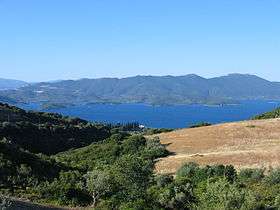Please tell us which country and city you'd like to see the weather in.

Pelion
Pelion or Pelium (Modern Greek: Πήλιο, Pílio; Ancient Greek/Katharevousa: Πήλιον. Pēlion) is a mountain at the southeastern part of Thessaly in central Greece, forming a hook-like peninsula between the Pagasetic Gulf and the Aegean Sea. Its highest summit, Pourianos Stavros, is 1,610 metres (5,280 ft) amsl. The Greek National Road 38 (GR-38) runs through the southern portion of the peninsula and GR-38A runs through the middle.
Geography and economy
The mountain is thickly forested, with both deciduous and perennial forests, mainly of beech, oak, maple and chestnut trees, with plane tree groves surrounding places with water. Pelion is considered one of the most beautiful mountains in Greece and is a popular tourist attraction throughout the year: hiking trails and stone paths give access to springs, coves and numerous beaches, sandy or pebbly, set among lusciously green slopes. Pelion is an amply watered mountain with an abundance of springs, gorges, streams and rivulets; many streams are routed in carved-stone artificial beds to bring water to the villages and their thriving orchards. The higher elevations of the mountain receive enough snowfall so as to host skiing facilities that operate from Christmas to Easter.

Pelion (Chaonia)
Pelion, also Pellion or Pelium (Greek: Πήλιον, Πέλλιον or Πήλεον), was a fortified settlement of the Chaonian tribe of Dexaroi, now located in Gorna Gorica (previously known as Goricë e Madhe) in Albania, on the ancient border between Epirus and Illyria. Pelium later served as a Macedonian border fortress. Sometime in 335 BC, just before the battle of Pelium, it was occupied by Dardanians, led by Cleitus of Dardania, who fought along with Glaucias of Taulanti against Alexander the Great.
See also
References
Coordinates: 40°53′39.12″N 20°54′10.08″E / 40.8942000°N 20.9028000°E
Radio Stations - Pelion
Podcasts:
Latest News for: pelion
Cy4Data Labs Secures a $10 Million First Round Led by Pelion Venture Partners to Transform ...
 Victoria Advocate
17 Apr 2025
Victoria Advocate
17 Apr 2025
Cy4Data Labs Secures a $10 Million First Round Led by Pelion Venture Partners to Transform How Data is Secured--Even While in Use
PR Newswire 17 Apr 2025Shock Announcement: Antonis Remos Quits Singing
Greek City Times 14 Apr 2025Pelion plans for enhanced global IoT proposition
Computer Weekly 07 Apr 2025- 1

